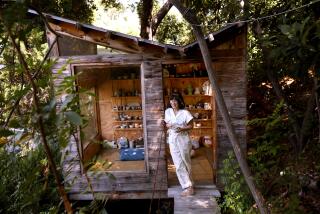How the politics and personalities of Portland’s art scene informed A24’s ‘Showing Up’
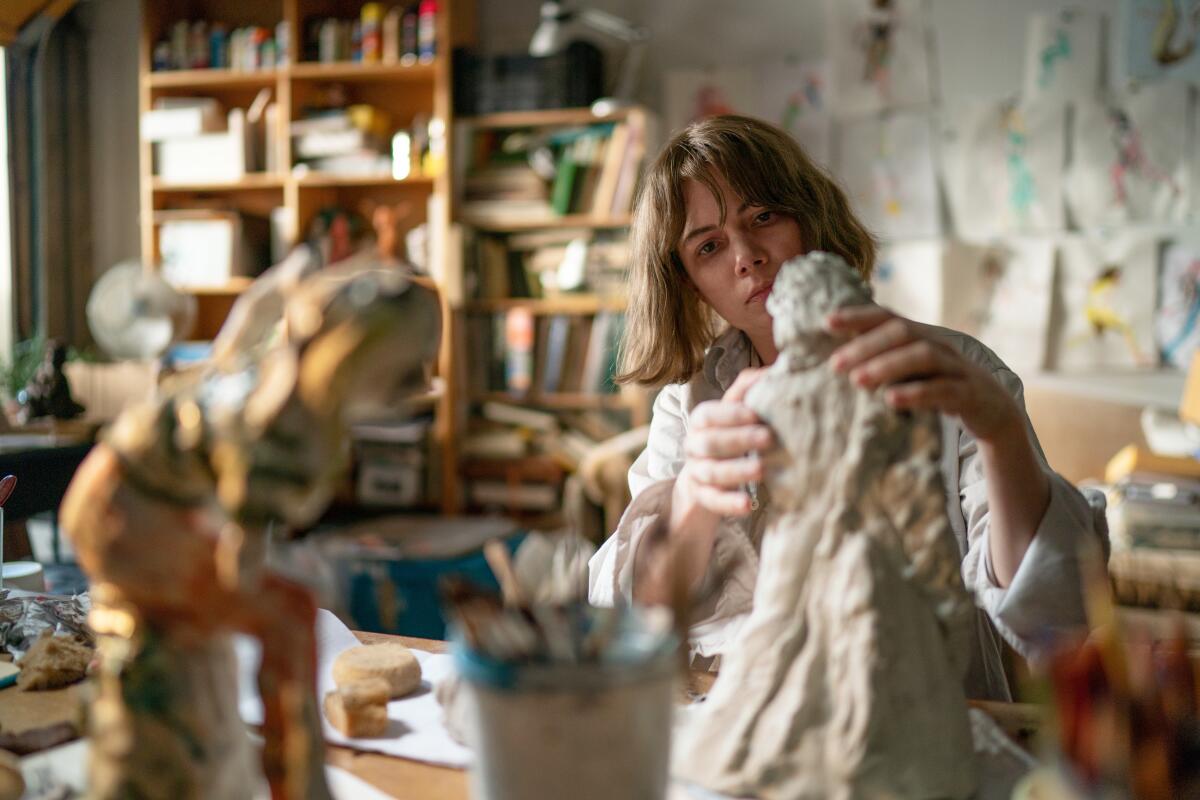
- Share via
A ceramic artist named Lizzy sits in her studio, nimbly bending the arm of a clay figurine. She examines her creation, then picks up a fork and scrapes the clay girl’s skirt. In doing so, she adds folds to the clothing and makes it look more realistic.
For ceramic artist Cynthia Lahti, this scene, performed by Michelle Williams in A24’s new film “Showing Up,” is a victory — an intentional moment of concentration between the artist and her art. “I totally taught her that,” Lahti says, recalling that she told Williams before filming, during one of their ceramic studio sessions, to “do the fork thing.”
In ‘Showing Up,’ her latest collaboration with Michelle Williams, the filmmaker burrows into the life of a frustrated Portland sculptor.
Lahti is one of many artists behind Kelly Reichardt’s film, which showcases the ordinary albeit dramatic and intertwined lives of those in the Portland, Ore., art scene. “Showing Up” follows sculptor Lizzy as she prepares new work for a gallery show. Trouble comes when she grapples with family issues, subtle quarrels with an artist friend who is also her landlord, and a fussy, misbehaving cat.
For Reichardt, this hits a lot closer to home than she anticipated: She ended up culling work from artists in Portland — where she’s based — for “Showing Up.”
Reichardt and co-writer Jonathan Raymond also turned to their relationships and interactions with people in the Oregon art world to create the world of “Showing Up.” Every time Reichardt traveled to Los Angeles, she’d catch up with friends and hear about the politics of artists and studios — and stories such as leveraging romantic relationships for gallery space. The oft-unexpected, unspoken dramas of tightknit arts communities captured the tone of the film Reichardt wanted to make.
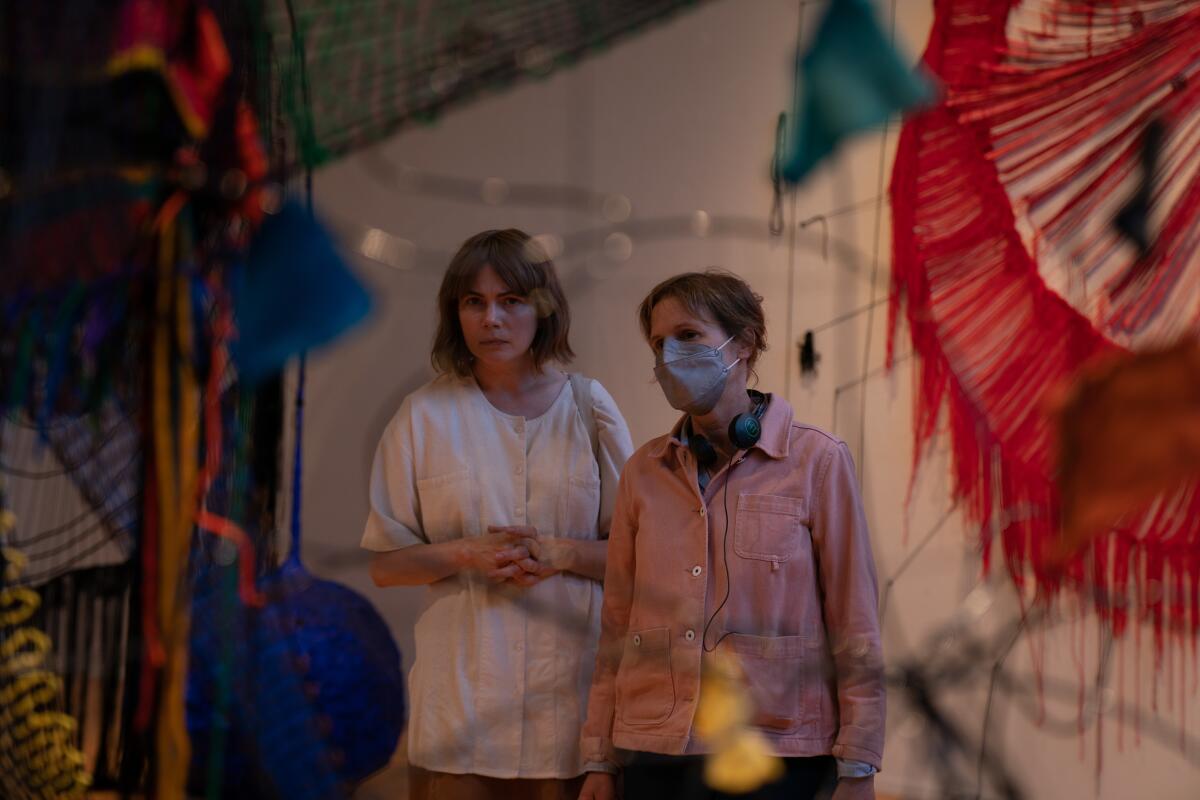
Reichardt and Raymond originally envisioned the film as a fictionalized account of real-life Canadian artist Emily Carr. They’d been inspired after reading her book “Growing Pains,” which documented her life making art and running a small apartment house in the early 20th century. But after traveling to Vancouver to learn more about Carr, they found themselves wanting to set the story elsewhere. Turns out the place they were searching for was in their own backyard.
“We came back to Portland and Jon started thinking about it more in terms of the life around us, which I found to be a very scary proposition to write about our contemporary artists,” Reichardt says. “It could go so wrong.”
The eventual story centered around artist-landlord Jo (Hong Chau) and Lizzy. Raymond and Reichardt wrote Lizzy’s character with Lahti’s work in mind.
Before filming, Williams participated in sculpture training sessions, both on Zoom and in-person at Lahti’s art studio in Portland. Lahti began by sculpting while Williams watched, and later the actor got her hands dirty and molded clay herself. “I was showing her how to sculpt,” Lahti says. “I think she just wanted to feel relaxed in the moment, where she felt like she was behaving like an artist might have.”
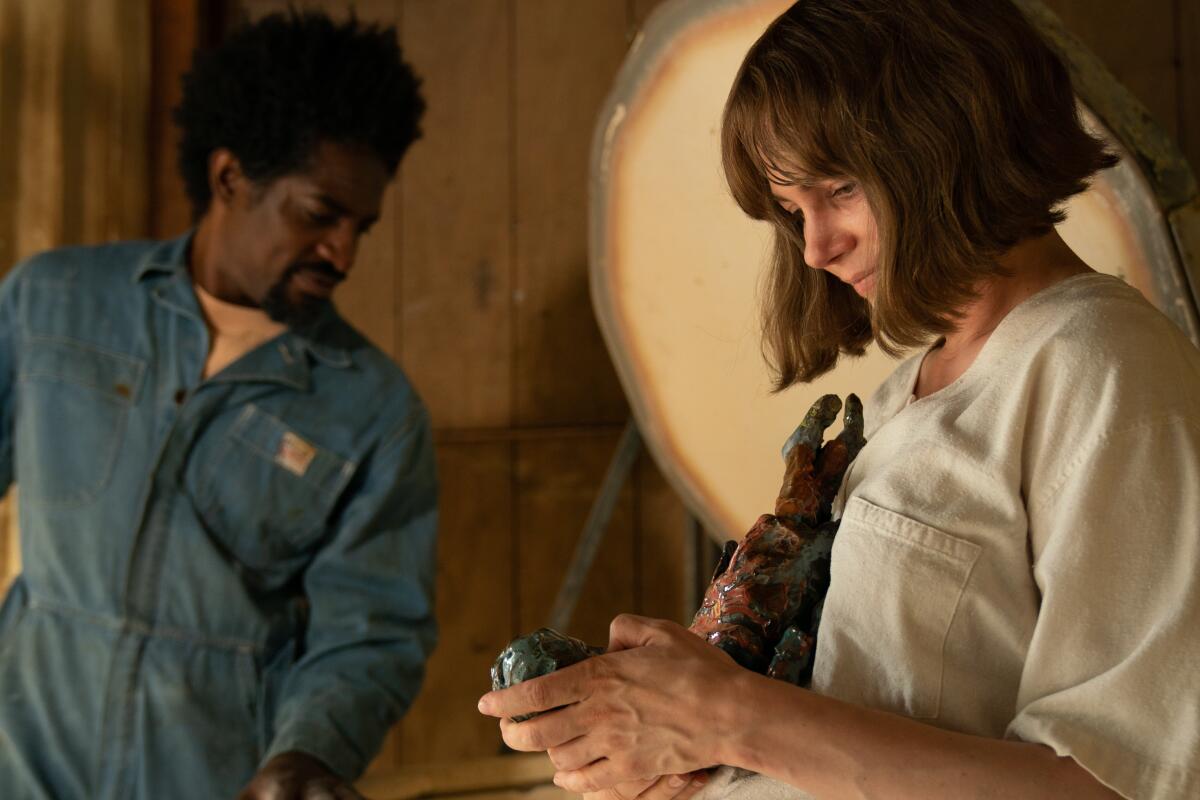
Williams’ Lizzy is dedicated to finishing every piece for an upcoming show, taking off work and spending nights in her basement studio. The scenes of Lizzy stepping into the basement felt particularly immersive for Lahti because a lot of her work, including drawings, covered the screen. The sense of immersion also came in the small details that Reichardt absorbed from conversations with Lahti.
“I remember talking to Kelly about how to make it look authentic,” Lahti says, such as how “ceramicists talk about something that’s just come out of the kiln ... or certain terminology that is very common.”
The poster for “Showing Up” stemmed from conversations between the filmmaker and artist too. Reichardt sent inspirational photos to Lahti, which galvanized her to create a “dancer series” of ceramic works — depicting girls mid-leap and with arms spread upward in expressive movements — that are featured in the film.
Other artists, including Michelle Segre and Jessica Jackson Hutchins, both of whom Reichardt previously worked with and filmed for “Où en êtes-vous ?” (What Stage Are You At?) with the Centre Pompidou, inspired characters in “Showing Up.”
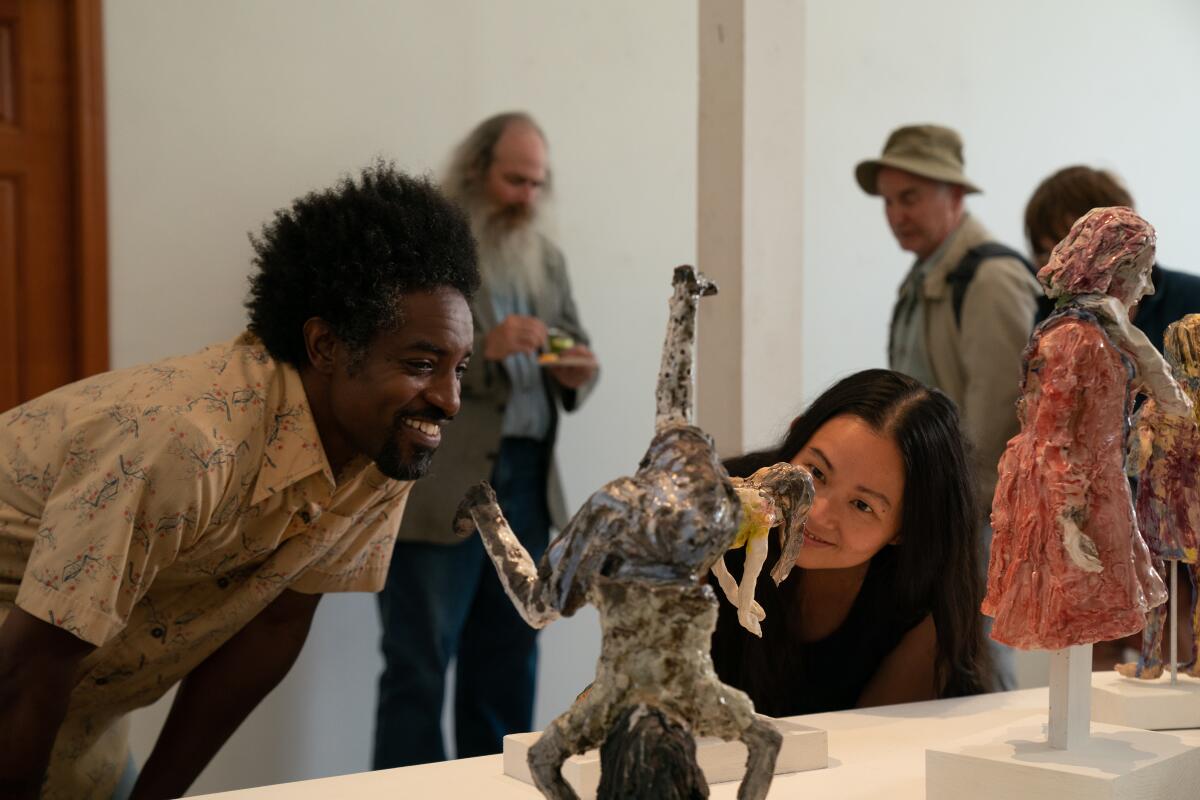
A Portland-based multimedia and assemblage artist, Hutchins is a longtime friend of both Reichardt and Raymond’s. Reichardt was particularly interested in Hutchins’ glasswork for the film. “It’s tactile and everything my work isn’t,” Reichardt says.
Hutchins’ work became central to the character of Marlene, the infamous artist-in-residence at the art school in “Showing Up.” Heather Lawless, who plays Marlene, took trips to Hutchins’ studio in preparation for the role, spending hours chatting and cutting glass with the artist.
Segre’s yarn and fabric sculptural pieces also became part of the feature film. When Reichardt was implementing the artist’s work into the story, Segre offered feedback on how pieces should be installed in the space — especially for the scene when Jo has a big solo show.
Each correlation of artist-to-character was intentional for Reichardt. She knew Chau’s character would work in a starkly different medium than Williams’ character.
“We filmed Michelle [Segre] for a couple of days and I really loved the idea of her work in contrast to Cynthia’s more full-body work — and less sitting at a desk,” Reichardt says.
Segre’s fiber and yarn sculptures were large and expansive, while Lahti’s were smaller in scale and made of clay. The relationship between Jo and Lizzy was depicted the contrast in mediums. “One, figurative, and then my work is more abstract,” Segre says.

The characters of “Showing Up” are connected by an art school. Inspired by the storied Black Mountain College in North Carolina, Reichardt created a fictional school and filmed on the old campus of the Oregon College of Art and Craft, which closed in 2019.
She identified rooms with sinks as classes that dyed work and found a room with a large loom that indicated weaving happened there. With the help of art consultant Libby Werbel and the film’s art department, Reichardt brought in local Portland artists to create work for the set. “Every room started having art being built in it,” she says.
While filling the school with art, everyone started learning new mediums from one another. And the woman seen knotting while the credits roll taught everyone how to work the looms.
“There were all these young people that came to be the actors to play the students in the film, and they were in a world unto themselves,” Reichardt says. “So it became an active school and a place of stuff being made.”
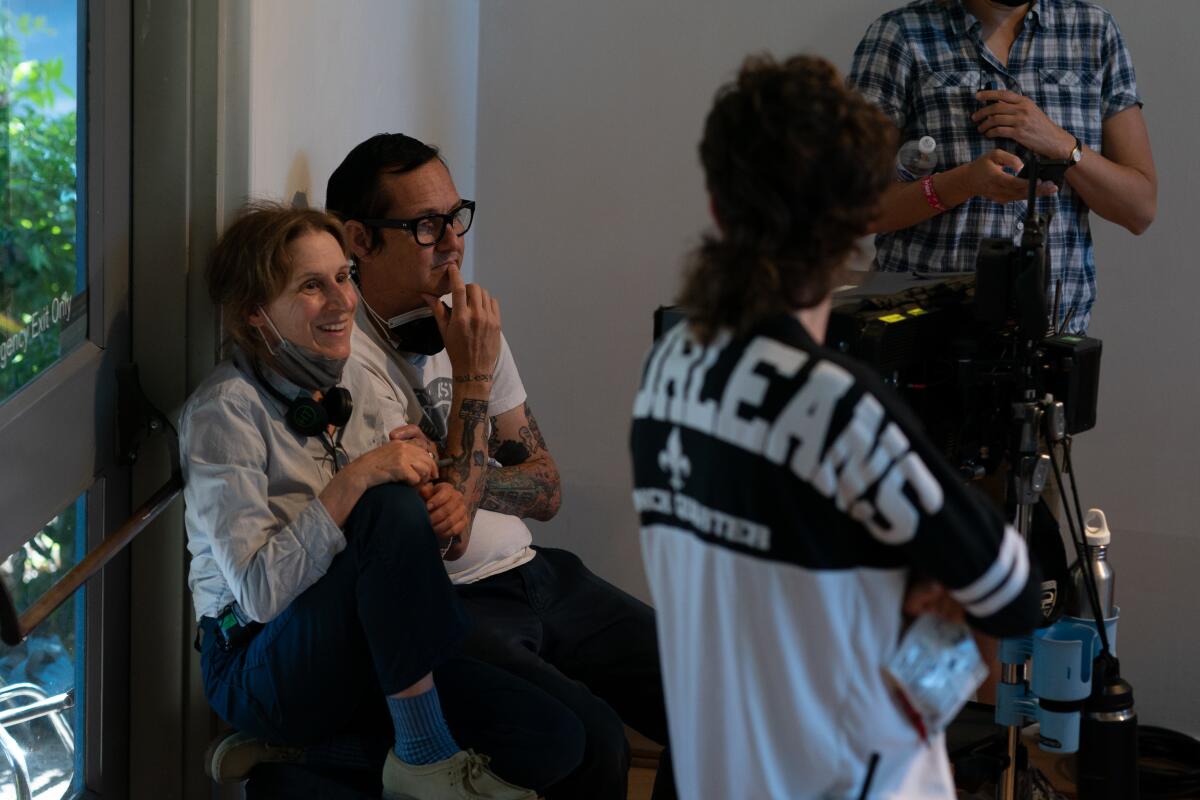
In the days before the film’s release, Lahti said she felt the same emotions as when she had a new show coming up: all the same insecurities with no context for what the release means in terms of exposure. When Segre saw the film, she felt weird seeing her work with a fictional character’s name on it. It was like “an alternate reality.”
Hutchins felt ambivalent, since the works she created were ultimately props for the film. But Hutchins identified with the “complex and rich” community the film depicted. As the film goes from show to show, for the most part, it’s the same faces looking at the work. It made her think of friendship and how it relates to creating art.
“There are these friendships underneath it [‘Showing Up’],” she says. “That’s one of the things I like about being an artist.”
More to Read
The biggest entertainment stories
Get our big stories about Hollywood, film, television, music, arts, culture and more right in your inbox as soon as they publish.
You may occasionally receive promotional content from the Los Angeles Times.



